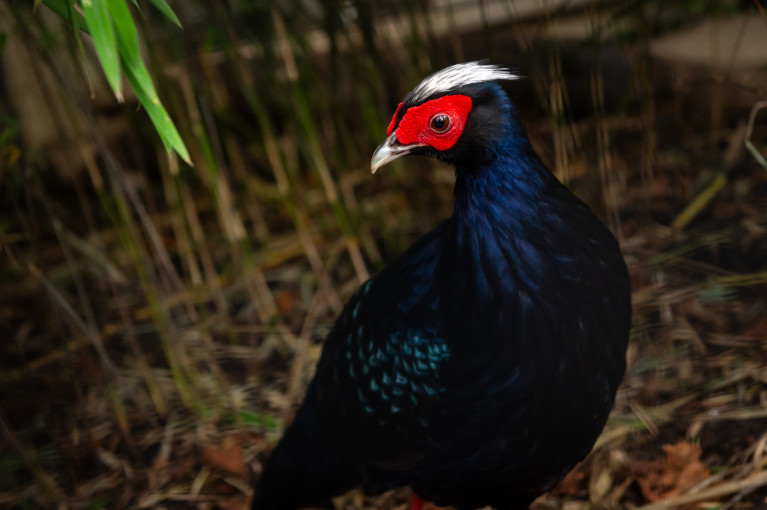A Frozen Treasure Trove for Science
A Frozen Treasure Trove for Science
Few people are aware of the extensive scientific research carried out behind the scenes at Antwerp ZOO and Planckendael ZOO. Every day, scientists are at work here on studies conducted into animal behaviour, health and well-being: from DNA analyses to determine paternity in chimpanzees to genetic research on the Vietnamese pheasant and cinereous vulture and fish welfare assessments.
Hidden among the operating theatres, analytical equipment, observation rooms and laboratories is a space that plays a decisive role in animal welfare, species preservation and nature conservation: the Biobank. At first glance, it seems no more than a collection of ultra-low freezers, but it is here that biological samples from thousands of animals are stored – safely, well-organised and readily accessible for research. It is thanks to this collection that zoos can carry out genetic research quickly and efficiently.

The Purpose of a Biobank
The Biobank is a centralised collection of biological samples taken from animals in zoos all over Europe.
‘These include blood, serum, tissue, hair and feather samples collected during routine examinations, medical procedures and post-mortem examinations,’ Research Coordinator Philippe Helsen explains.
‘These include blood, serum, tissue, hair and feather samples collected during routine examinations, medical procedures and post-mortem examinations,’ Research Coordinator Philippe Helsen explains. Each sample contains a unique source of genetic information and represents a fragment of the biodiversity safeguarded by zoos. ‘By storing all of these samples safely and in a standardised manner in a single location, they remain accessible for future research – whether this concerns health, genetics, population management or nature conservation.’
The Biobank was established by Antwerp ZOO and fellow institutes because samples were previously scattered across different zoos or difficult to trace, which often delayed important research. By keeping them in a central location, scientists can find answers to crucial research questions more quickly and efficiently. There are only four Biobanks in Europe that store samples from zoos. They are located in Berlin, Edinburgh, Copenhagen and Antwerp.
What Happens in a Biobank?
When a sample arrives at the research centre, it is placed in a -20°C freezer for temporary storage – a kind of logistical distribution centre where all new consignments arrive before being processed. Every year, thousands of samples are sent here from zoos across Europe.
The real work, however, only begins afterwards. Each sample is carefully logged and linked to the animal’s data: species, sex, age, origin and the reason for taking the sample. Next, the samples are processed and transferred to the Biobank’s -80°C ultra-low freezers for long-term storage without any loss of quality.
Every centimetre of these freezers is systematically organised. A single drawer in the temporary -20°C freezer can hold up to 400 samples. After processing, they are redistributed in the -80°C freezer into compact boxes, each containing 100 neatly arranged samples. ‘This means that a full drawer, which may seem rather chaotic when you first look at it, ends up neatly sorted into small boxes after processing,’ Helsen explains. A copy of every sample stored in the Antwerp ZOO Biobank is also kept in Berlin, and vice-versa. ‘In the event of a power failure no samples will be lost.’
The Biobank currently holds around 30,000 samples, and a single freezer has capacity for 80,000. ‘Our goal is not to fill that capacity, but to make use of it. A sample that helps answer a research question is far more valuable than a test tube that remains untouched in a freezer.’ In other words, the Biobank is not a museum collection but a living data resource for scientific research.

What Makes These Samples so Valuable?
‘Many animals in zoos are part of an international species-conservation programme aimed at maintaining the genetic health of endangered species,’ explains laboratory technician Jordi de Raad. ‘Genetic information makes all the difference.’ DNA analysis allows researchers to determine:
- the extent of a population’s genetic diversity;
- which animals are related and which are not;
- the suitability of specific couples for future breeding;
- the accuracy of herd book data and/or any gaps in these records; and
- which animals are genetically crucial for reintroduction into the wild.
For some species, the Biobank is the only realistic source of genetic material. ‘Take the okapi, for instance. These animals live deep in the forests of Congo and are so elusive that collecting samples in the wild is virtually impossible,’ continues De Raad.
‘Because we have them here in our zoo, reliable samples are available for research that ultimately benefits their wild counterparts.’
‘Because we have them here in our zoo, reliable samples are available for research that ultimately benefits their wild counterparts.’
Another striking example is the Vietnamese pheasant, which is now virtually extinct in the wild. There are only a few left in zoos and private collections. ‘Biobank samples make it possible to determine which individuals are suitable for reintroduction and which should remain within the conservation programme a little longer to help build genetic diversity,’ Helsen continues. ‘In fact, the restoration plan does not start in the field but in the freezer.’

The Future: The Biobank as a Driver of Nature Conservation
As DNA research is becoming increasingly efficient and affordable, the value of the Biobank will only continue to grow. The collection may enable forms of research that do not yet exist, but could prove crucial for species conservation tomorrow.
The ultimate goal is clear: to retain as few samples as possible in the freezer, and to use as much knowledge as possible drawn from it to support the protection of species. Every sample that is analysed helps us deepen our understanding of how to keep populations healthy, protect endangered species and safeguard future biodiversity.

